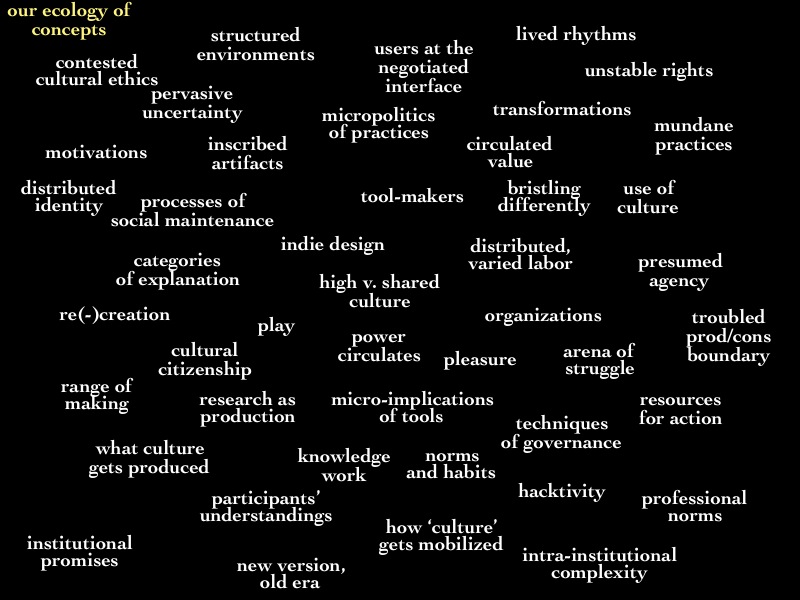We face an increasingly complex ecology of digital technologies and cultural production outlets: blogs, video games, Facebook, wikis, media platforms, Twitter, etc.
And we are finding that they present substantive challenges to our ways of understanding the workings and implications of cultural production. We are witnessing the establishment of digital culture, not just as a novelty or a challenge, but also as the central means for public expression. In March of 2011 we met as a group to discuss these issues and from those discussions emerged a series of questions and topics that many of us believe will lead to understanding contemporary phenomena in cultural production as more than the particular public controversies, or the “impact” of a single new technology, or a shift in a specific cultural form.
We began our discussion with the following understanding: cultural production in the digital age is complex and layered; in online spaces and through digital technologies, users produce not just content; they also produce provisional communities, knowledge resources, political organizations, and homegrown economies. The technologies involved do not merely mediate the movement of word and image; they mediate every level of this production. The emergent processes, social relations and tools of digital culture and its rendering suggest a blueprint for the future of cultural discourse. Research questions and scholarly discussions that are still entranced with either novelty or nostalgia, that can only see the modern formation and its predecessor in stark contrast, that assume these new formations to be external to and impinging upon the social fabric, are insufficient.
What we thought we might contribute then is a multi-disciplinary project engaged in the collaborative development of theoretical insights that make sense of the thorough-going re-formation of public culture, without falling back on the shorthand of “evolution,” “revolution,” or “devolution.”
During our workshop we engaged in an inspiring conversation about the meaning of cultural production, asking ourselves what the terms meant and how they might be/had been conceptualized for digital technologies and media. We developed an extensive “cloud of terms,” which made us realize that the concept of cultural production remained illusive as a term that could encapsulate what each us individually conceived as the forces and dynamics at play. We had different ideas and visions of users. We imagined creators, consumers, citizens, men, women, the young, the old, gamers, prosumers, playborers or any other type of category of user that might be engaged in digital media and its capacities and/or affordances (terms which themselves were found to be in need of reevaluation). Central to our discussions was the place of human beings in the matrix of technology, history, culture and institutions that buttress “cultural production” digital or otherwise.
At the core of our discussion were questions that would help unpack the constellation of dynamics, categories, forces and artifacts that summed up to be cultural production in the digital age. These questions would also help us draw connections between these elements, mapping them onto enduring phenomena in society: power relations, identity, historical contingency, human flourishing, and creativity to name but a few.
These questions, artifacts of our ruminations, attempted to push us to map the connections between humans, their culture, their tools, their institutions and their histories. That map (or maps) would be informed by our collective expertise as researchers, participants, observes and archivers of media environments and their histories. Through our discussion of these questions we hoped for not only answers but also means of transcending our “natural inclinations” for easy collaboration. One goal that remained salient throughout our workshop was not only how we might speak to those who understand us best, but also how we might learn from those whose ideas, methods and goals for research are alien us. We believe that engaging in collaboration across disciplines will polish the lenses (theoretical and methodological) through we understand our respective topics and knowledge base. Ultimately our questions seek to understand how technology is weaved into lived practices. How “technical affordances” as a conceptual tool for understanding humans and their experience of technical systems can be unpacked further and how those affordances are the result of complex design choices and interactions of which designer’s micro-intuitions are no small part. We hope that the expertise of history will give us the long view of our topic, that the expertise of design and practice will help make our research an intervention in ways we had not envisioned and that humanistic methods of may show us the nuances of power even in its most naturalized forms.
In the following months we will return to the questions and themes above. We will play with them collaboratively, revisit our thinking from our workshop, identify topics to explore, problems to solve. Given our diverse group we will tackle our task in a number of ways. These include collaborative thinking via this blog and our backstage section. Content will be driven by “thought pieces”, through real time play involving tools we will implement in this space and other ways of fleshing out our thinking. We hope to identify research agendas that might help us address our questions, we will identify funding sources to extend that research and identify other partners in the scholarly/practitioner community that will help this project grow.

